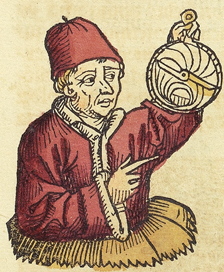Regiomontanus (nonfiction)
Johannes Müller von Königsberg (6 June 1436 – 6 July 1476), better known as Regiomontanus, was a mathematician and astronomer of the German Renaissance, active in Vienna, Buda and Nuremberg. His contributions were instrumental in the development of Copernican heliocentrism in the decades following his death.
Regiomontanus wrote under the latinized name of Ioannes de Monteregio (or Monte Regio; Regio Monte); the adjectival Regiomontanus was first used by Philipp Melanchthon in 1534.
At eleven years of age, Regiomontanus became a student at the university in Leipzig, Saxony. In 1451 he continued his studies at Alma Mater Rudolfina, the university in Vienna, Austria. There he became a pupil and friend of Georg von Peuerbach.
In 1452 he was awarded his "magister artium" (Master of Arts) at the age of 21 in 1457. It is known that he held lectures in optics and ancient literature.
Regiomontanus continued to work with Peuerbach learning and extending the then known areas of astronomy, mathematics and instrument making until Peuerbach's death in 1461.
In 1461 Regiomontanus left Vienna with Bessarion and spent the next four years travelling around Northern Italy as a member of Bessarion's household, looking for and copying mathematical and astronomical manuscripts for Bessarion, who possessed the largest private library in Europe at the time. Regiomontanus also made the acquaintance of the leading Italian mathematicians of the age such as Giovanni Bianchini and Paolo dal Pozzo Toscanelli who had also been friends of Peuerbach during his prolonged stay in Italy more than twenty years earlier.
He went to work for János Vitéz, archbishop of Esztergom.[year needed] There he calculated extensive astronomical tables and built astronomical instruments. In 1467 he went to Buda, and the court of Matthias Corvinus of Hungary, for whom he built an astrolabe, and where he collated Greek manuscripts for a handsome salary. The tables that he created while living in Hungary, his Tabulae directionum, were designed for astrology, including finding astrological houses.
In 1471 Regiomontanus moved to the Free City of Nuremberg, in Franconia, then one of the Empire's important seats of learning, publication, commerce and art, where he worked with the humanist and merchant Bernhard Walther. Here he founded the world's first scientific printing press, and in 1472 he published the first printed astronomical textbook, the Theoricae novae Planetarum of his teacher Georg von Peurbach.
Regiomontanus and Bernhard Walther observed the comet of 1472. Regiomontanus tried to estimate its distance from Earth, using the angle of parallax
In the News
Fiction cross-reference
Nonfiction cross-reference
External links:
- Regiomontanus @ Wikipedia
